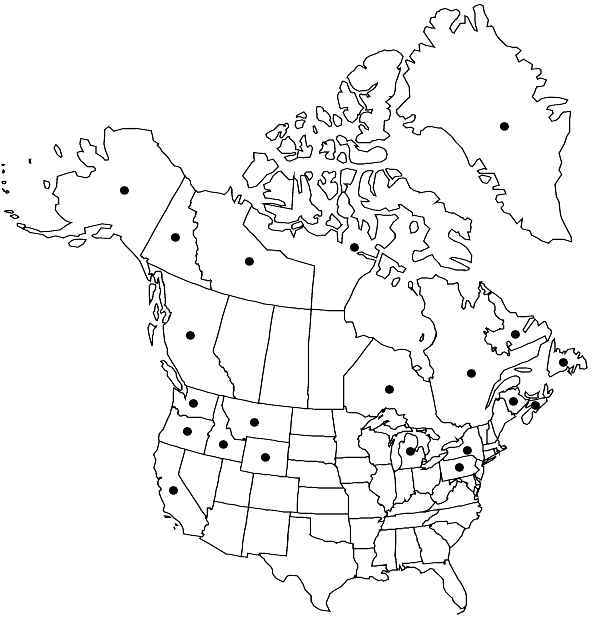Niphotrichum ericoides
in R. Ochyra et al., Cens. Cat. Polish Mosses, 138. 2003,.
Plants moderately sized to fairly large, occasionally small, loosely or densely caespitose or forming extensive mats, yellow- or olive green, rarely dark green in the uppermost part, brown to blackish brown proximally. Stems (1–)3–8(–12) cm, prostrate to ascending, mostly pinnately branched, occasionally almost unbranched. Leaves appressed and slightly twisted when dry, erect-spreading to somewhat recurved when moist, ovate-lanceolate to subtriangular, 2–3 × 0.9–1.2 mm; margins broadly recurved to revolute throughout; apices gradually long-acuminate, sharply keeled, plicate, piliferous or not infrequently muticous, awns erect or sometimes reflexed-flexuose, capillaceous, slightly decurrent, weakly denticulate, slightly papillose to epapillose distally, slightly to strongly papillose in the basal part with low or sometimes high and narrow papillae; costa percurrent, lying at the bottom of a shallow and wide-angled furrow and strongly flattened in the basal part, (65–)75–100 µm wide; basal laminal cells elongate, 40–50 × 4–6 µm, with moderately thickened, nodulose and porose longitudinal walls, papillose with relatively low and narrow papillae, except for 1–4 epapillose cells at the insertion; alar cells rounded, thin-walled and hyaline in 3–5 rows, forming rounded and convex auricles; supra-alar cells elongate, with thin, straight or weakly sinuose walls, forming a transparent marginal border consisting of 10–15 cells; medial and distal laminal cells rectangular, 10–20 × 6–10 µm, papillose with relatively low and narrow papillae. Inner perichaetial leaves membranous, hyaline to yellowish hyaline, piliferous. Seta dark to reddish brown, lustrous, 12–15 mm. Capsule brown, long-cylindric, 1.5–2 mm, sulcate when dry; peristome teeth 600–800 µm, reddish brown to red, split to the base into 2 filiform branches, finely densely papillose. Spores 9–12 µm.
Habitat: Dry or intermittently moist sites that are generally shaded, less often open and insolated, sandy, gravelly or gritty soil, humus and soil over rocks, boulders and rock ledges, grassland, stony ground and roadside banks, floor in mesic to dry woodlands and forests, stabilized dunes and disturbed places, various tundra communities, predominantly non-calcareous substrates
Elevation: low to moderate elevations (0-1600 m)
Distribution

Greenland, B.C., N.B., Nfld. and Labr., N.S., Nunavut, N.W.T., Ont., Que., Yukon, Alaska, Calif., Idaho, Mich., Mont., N.Y., Oreg., Pa., Wash., Wyo., Europe, Arctic and temperate Asia, Atlantic Island (Azores, Iceland).
Discussion
Niphotrichum ericoides is a fairly frequent species, with a bicentric distribution in North America. It is most common in the western part of the continent, from Alaska to northern California and in the Rocky Mountains of Idaho and Wyoming. In eastern North America it is less frequent, and scattered from northern Labrador south to Pennsylvania. Apart from N. panschii, it is the only species of the genus that penetrates into the high Arctic in Nunavut, the Yukon Territory, and Alaska. The global range of N. ericoides also includes arctic, boreal, and temperate Europe, southwards to the Azores; in Asia, it is very rare in the Arctic, Siberia, and Japan. The material reported from Santiago, Chile, as Racomitrium canescens (He S. 1998; Mahu 10543, MO) also represents N. ericoides, but that attribution is fairly suspicious and possibly a result of a confusion of herbarium labels.
Niphotrichum ericoides has been considered to be very close to N. canescens and is usually recognized under the latter. However, the two taxa are not likely to be mistaken. The sharply keeled leaves in the distal portion, a percurrent costa, and the epapillose awns will safely discriminate N. ericoides. This species is more likely to be confused with N. elongatum, with which it often grows in mixed stands and shares the regularly pinnately branched habit with short, tuft-like lateral branchlets, which gives them both a nodose appearance. However, in N. ericoides the branchlets are erect-spreading when dry, whereas in N. elongatum they are recurved to squarrose at their apex. The awn in N. ericoides is erect-flexuose when dry, not or indistinctly decurrent, and often faintly denticulate to smooth. In contrast, the awns in N. elongatum are distinctly recurved, long-decurrent, and often sharply denticulate. Microscopically these species are easily separated by the shape of their supra-alar cells. In N. ericoides they are elongate and thin- and straight-walled, and form a distinct, transparent basal marginal border; in N. elongatum they are short, thick- and sinuose-walled, and opaque and not markedly different from the adjacent laminal cells.
Selected References
None.